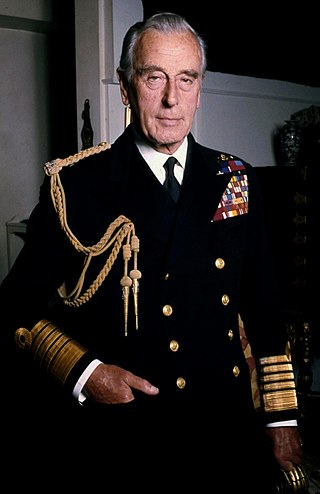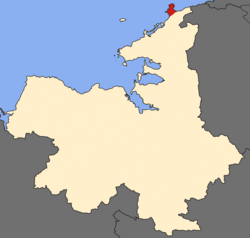Assassination of Lord Mountbatten
1979 bomb attack in Mullaghmore, Ireland From Wikipedia, the free encyclopedia
Louis Mountbatten, a relative of the British royal family, was assassinated on 27 August 1979 by Thomas McMahon, an Irish republican and a volunteer for the Provisional Irish Republican Army (PIRA).
| Assassination of Louis Mountbatten, 1st Earl Mountbatten of Burma | |||||
|---|---|---|---|---|---|
| Part of The Troubles | |||||
 | |||||
| Location | Mullaghmore Peninsula, Ireland | ||||
| Coordinates | 54.4664°N 8.4486°W | ||||
| Date | 27 August 1979 | ||||
| Target | Lord Mountbatten | ||||
| Weapon | Bomb | ||||
| Deaths |
| ||||
| Injured |
| ||||
| Perpetrator | Provisional IRA | ||||
| Assailant | Thomas McMahon | ||||
| Motive | Irish republicanism | ||||
| Convicted | Thomas McMahon | ||||
| Charges | Murder | ||||
| |||||

Assassination
Summarize
Perspective
The IRA placed a 50 pounds (23 kg) gelignite bomb on Shadow V, a fishing boat owned by Mountbatten, while she was harboured overnight in Mullaghmore Peninsula in County Sligo, Republic of Ireland. The bomb was detonated several hours later, after Mountbatten and his family and crew had boarded her and taken her offshore. Mountbatten was found alive by fishermen who rushed to the site of the explosion, but he died before reaching shore. Also killed were Mountbatten's 14-year-old grandson Nicholas Knatchbull, and Paul Maxwell, a teenage boy from Enniskillen serving as crew. The four others aboard—Mountbatten's daughter Patricia; her husband John Knatchbull; their son Timothy (twin brother of Nicholas); and John Knatchbull's mother Doreen—were all seriously injured. Doreen Knatchbull died in hospital the following day.[1][2]
The assassination took place during the Troubles, a conflict between republicans and unionists in Northern Ireland following the Partition of Ireland.[3] The PIRA claimed responsibility 5 hours after the bombing;[4] later on 30 August they issued a statement, describing the attack as "a discriminate act to bring to the attention of the English people the continuing occupation of our country".[5]
Mountbatten was a great-grandson of Queen Victoria, second cousin to Queen Elizabeth II, and uncle to her husband Prince Philip, Duke of Edinburgh.[6] As Chief of the Defence Staff, Mountbatten served as head of the British Armed Forces from 1959 to 1965,[7] having previously headed the Royal Navy as the First Sea Lord.[8] Sinn Féin vice-president Gerry Adams said that Mountbatten was a military target in a war situation.[9]
Two hours before the explosion, McMahon had been arrested by the Garda Síochána on suspicion of driving a stolen vehicle.[10] Paint from Mountbatten's boat, and traces of nitroglycerine, were found on his clothes, and on 23 November 1979 he was convicted of the killings in the Republic of Ireland. His sentence was life imprisonment.[11][12]
The assassination marked an escalation of the conflict, with the IRA conducting its deadliest attack on the British Army (the Warrenpoint ambush) on the same day as the assassination.[13] Thatcher changed Britain's approach by coordinating the various British security services campaigns against the IRA more centrally and used the SAS more aggressively to kill known IRA volunteers who were on active operation. Thatcher was herself the target of an assassination attempt five years later.[14] McMahon was paroled from his life sentence in 1998 after 19 years in prison under the terms of the Good Friday Agreement, as part of the Northern Ireland peace process which brought an end to the Troubles after three decades.[15]
Reactions
Summarize
Perspective
The killing was condemned by UK Prime Minister Margaret Thatcher and Irish Taoiseach Jack Lynch. Many international figures offered their condolences to the royal family, including US President Jimmy Carter and Pope John Paul II.[16][17] The United States Department of State said: "Americans will especially recall his great contribution to our common cause in World War II as well as his many services to this country and to the world since then."[18]
Three days of state mourning was announced in Burma (now known as Myanmar), while in India where he served as the last Viceroy and first Governor-General, a week of mourning was observed.[19] The Gazette of India published an extraordinary obituary notice, the All India Radio broadcast a short tribute including statements by former Prime Minister of India Indira Gandhi who called him "an extraordinary personality, a lion, a born leader of men".[18] Tribute to Lord Mountbatten, a television special on DD National was broadcast, led by Prime Minister Charan Singh; it included Indira Gandhi and other Indian leaders.[20] Singh also signed the condolence book at the British High Commission, New Delhi.[21] Providing condolences, the President of India Neelam Sanjiva Reddy said in a message to Queen Elizabeth II "Lord Mountbatten will always occupy a place of honor in India."[18] PM Charan Singh remarked that Mountbatten's "drive and vigour helped in the difficult period after our independence".[22]
The assassination also horrified the Irish American community, who viewed Mountbatten as a hero for his role in defeating the Axis powers during World War II (many American soldiers in the war served under him),[23][24][25] and IRA financial support in America via NORAID dwindled,[26] which was already in steep decline since the mid-1970s.[27] The American press condemned the attack, including The Boston Globe, which said "the Provisional army's action against Mountbatten and others engenders no sympathy for their cause" and The New York Times, which suggested that the Republic of Ireland and Britain team up as a means of "how to punish the IRA."[25] The Federal Bureau of Investigation, which succeeded in greatly reducing the IRA arms importation into Ireland from America at the time of the killing, responded by forming the PIRA Squad in order to effectively track down IRA gunrunners who were engaged in procuring American arms.
Funeral
On 5 September 1979, the ceremonial funeral was held at Westminster Abbey under tight security,[28] attended by Queen Elizabeth II, the Royal Family, other members of European royal houses, Prime Minister Margaret Thatcher and all of her surviving predecessors. Thousands of people turned out for the funeral procession, which began at Wellington Barracks, including representatives of the three Armies and military contingents from Burma, India, the United States, France and Canada.[28] His coffin was carried in a cavalry armor and it was also accompanied by 118 members of the Royal Navy. The funeral service was televised on BBC1 and the Prince of Wales read Psalm 107.[28] In that address, the Archbishop of Canterbury, Donald Coggan, highlighted several passages from his life in the Royal Navy. After the public ceremony, which he had planned, he was buried in Romsey Abbey. As part of the funeral arrangements for him, his body was embalmed by Desmond Henley.[28]
See also
References
Wikiwand - on
Seamless Wikipedia browsing. On steroids.

